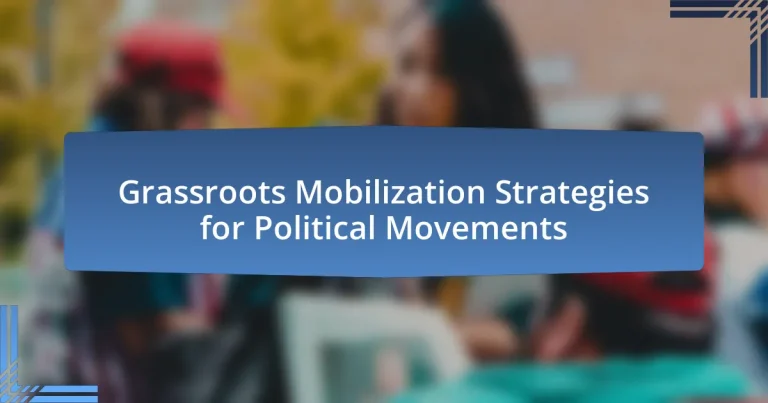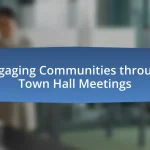Grassroots mobilization strategies for political movements focus on engaging and organizing community members to advocate for change at the local level. These strategies include door-to-door canvassing, community meetings, social media campaigns, and coalition-building, which empower individuals and enhance democratic participation. The article explores the differences between grassroots and traditional political strategies, key characteristics of effective grassroots mobilization, and the importance of community engagement in achieving political goals. It also examines the challenges faced by grassroots movements, the role of funding and resources, and successful historical and contemporary examples that illustrate the impact of grassroots efforts on policy change and civic engagement.
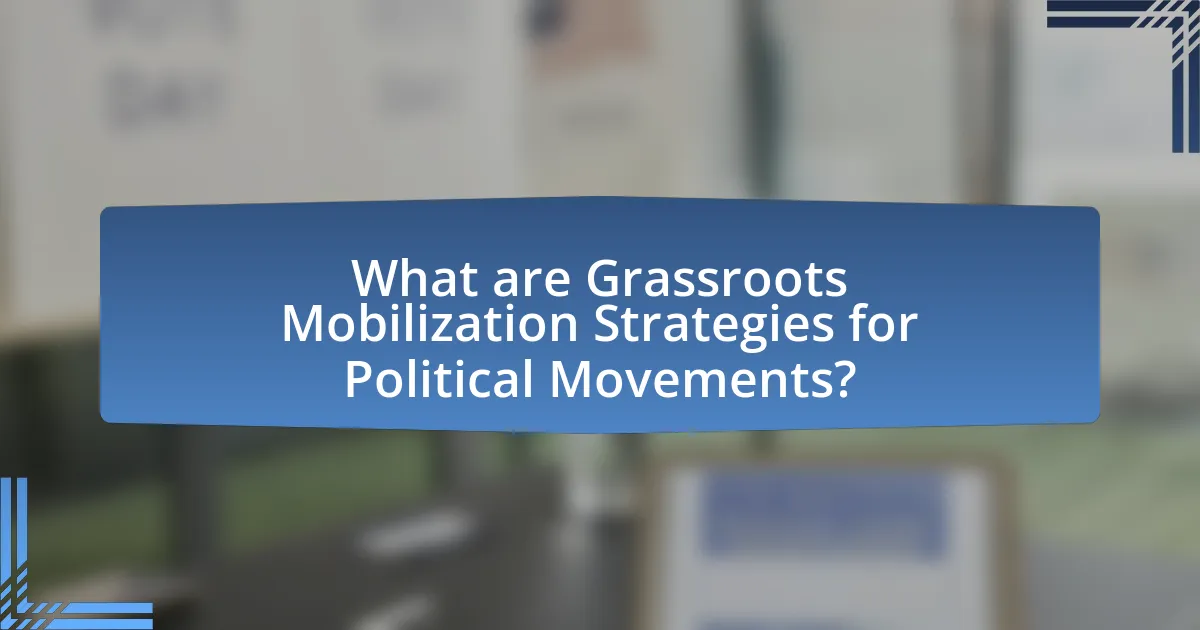
What are Grassroots Mobilization Strategies for Political Movements?
Grassroots mobilization strategies for political movements involve organizing and engaging community members to advocate for change at the local level. These strategies typically include door-to-door canvassing, community meetings, social media campaigns, and coalition-building with local organizations. For instance, the 2018 midterm elections in the United States saw significant grassroots efforts, where organizations like Indivisible mobilized thousands of volunteers to engage voters directly, resulting in increased voter turnout. Such strategies are effective because they empower individuals, create a sense of community ownership, and leverage local networks to amplify voices and demands for political action.
How do grassroots mobilization strategies differ from traditional political strategies?
Grassroots mobilization strategies focus on engaging and empowering local communities to drive political change, while traditional political strategies often rely on established institutions and top-down approaches. Grassroots efforts prioritize direct participation, utilizing social networks and community organizing to build support from the ground up, as seen in movements like the Civil Rights Movement, which effectively mobilized local activists to challenge systemic injustices. In contrast, traditional strategies typically involve formal party structures, professional campaign teams, and reliance on media advertising, which can create a disconnect from the grassroots level. This distinction highlights how grassroots mobilization fosters a sense of ownership and agency among participants, leading to more sustainable and inclusive political engagement.
What are the key characteristics of grassroots mobilization?
Grassroots mobilization is characterized by community-driven efforts that prioritize local engagement and participation. This approach often involves building networks of individuals who share common interests or goals, fostering a sense of ownership and empowerment among participants. Key characteristics include decentralized organization, where leadership emerges from within the community rather than being imposed from above; inclusive participation, ensuring diverse voices are heard; and strategic use of social media and local events to raise awareness and mobilize support. Evidence of its effectiveness can be seen in movements like the Civil Rights Movement, where grassroots efforts led to significant social change through collective action and community solidarity.
Why is grassroots mobilization important in contemporary politics?
Grassroots mobilization is important in contemporary politics because it empowers ordinary citizens to influence political processes and decisions. This form of mobilization fosters community engagement, enabling individuals to advocate for issues that directly affect their lives, thereby enhancing democratic participation. For instance, movements like Black Lives Matter and climate activism have demonstrated how grassroots efforts can lead to significant policy changes and raise awareness on critical social issues. Research shows that grassroots campaigns often result in higher voter turnout and increased political accountability, as seen in the 2018 midterm elections in the United States, where grassroots organizations played a crucial role in mobilizing voters.
What are the primary goals of grassroots mobilization?
The primary goals of grassroots mobilization are to empower communities, influence policy change, and increase civic engagement. Grassroots mobilization seeks to build a collective voice among individuals, enabling them to advocate for their interests and drive social or political change. This approach often involves organizing local events, fostering community networks, and utilizing social media to amplify messages. Research indicates that grassroots movements can effectively sway public opinion and lead to significant legislative outcomes, as seen in various social movements throughout history, such as the Civil Rights Movement, which successfully mobilized citizens to demand equal rights and resulted in landmark legislation.
How do grassroots movements aim to influence policy?
Grassroots movements aim to influence policy by mobilizing community members to advocate for specific changes through collective action. These movements utilize strategies such as organizing protests, engaging in lobbying efforts, and leveraging social media to raise awareness and build public support. For instance, the Civil Rights Movement in the 1960s effectively used grassroots organizing to challenge segregation laws, leading to significant legislative changes like the Civil Rights Act of 1964. This demonstrates that grassroots movements can create substantial pressure on policymakers by demonstrating widespread public support for their causes.
What role does community engagement play in achieving these goals?
Community engagement is essential for achieving the goals of grassroots mobilization strategies in political movements. It fosters a sense of ownership and collective responsibility among community members, which enhances participation and commitment to the movement’s objectives. Research indicates that when communities are actively involved, they are more likely to mobilize resources, share information, and advocate for change effectively. For instance, a study by the Stanford Social Innovation Review found that community-driven initiatives are 50% more likely to succeed in achieving their goals compared to top-down approaches. This demonstrates that community engagement not only empowers individuals but also amplifies the overall impact of political movements.
What are the essential components of effective grassroots mobilization?
The essential components of effective grassroots mobilization include community engagement, clear messaging, strategic organization, and sustained follow-up. Community engagement fosters trust and builds relationships, which are crucial for mobilizing individuals around a common cause. Clear messaging ensures that the goals and values of the movement are communicated effectively, making it easier for supporters to understand and rally behind the initiative. Strategic organization involves planning and coordinating activities, such as events and outreach efforts, to maximize impact and participation. Sustained follow-up maintains momentum and keeps supporters informed and involved, which is vital for long-term success. These components are supported by historical examples, such as the Civil Rights Movement, where effective grassroots mobilization led to significant social change.
How does grassroots organizing build community networks?
Grassroots organizing builds community networks by fostering direct relationships among individuals and groups, creating a foundation for collective action. This approach encourages participation through local meetings, workshops, and outreach efforts, which help to identify shared interests and concerns within the community. For instance, studies show that grassroots movements, such as the Civil Rights Movement, effectively mobilized individuals by establishing local chapters that connected people to a larger cause, thereby strengthening community ties and enhancing social capital. These networks facilitate communication, resource sharing, and mutual support, ultimately empowering communities to advocate for their needs and influence political change.
What tools and technologies are utilized in grassroots mobilization?
Grassroots mobilization utilizes various tools and technologies, including social media platforms, mobile applications, email marketing, and data analytics software. Social media platforms like Facebook and Twitter facilitate communication and engagement, allowing organizations to reach a broad audience quickly. Mobile applications enable real-time updates and coordination among supporters, while email marketing tools help in disseminating information and rallying support. Data analytics software assists in understanding voter behavior and targeting specific demographics effectively. These technologies have been proven to enhance outreach and engagement, as evidenced by the success of movements like the Arab Spring, where social media played a crucial role in mobilizing protests.
How can grassroots mobilization strategies be evaluated for effectiveness?
Grassroots mobilization strategies can be evaluated for effectiveness through measurable outcomes such as participation rates, engagement levels, and the achievement of specific goals. For instance, analyzing the number of attendees at events, the volume of social media interactions, and the success in influencing policy changes provides concrete metrics. Research by the Stanford Social Innovation Review indicates that effective grassroots movements often see a direct correlation between increased community involvement and successful advocacy outcomes, demonstrating that higher engagement leads to more significant impact.
What metrics are used to assess the success of grassroots movements?
Metrics used to assess the success of grassroots movements include participation rates, fundraising totals, media coverage, and policy changes. Participation rates measure the number of individuals engaged in activities, indicating the movement’s reach and mobilization effectiveness. Fundraising totals reflect the financial support and sustainability of the movement, while media coverage assesses public visibility and narrative control. Policy changes serve as a direct indicator of influence, demonstrating the movement’s ability to affect legislative or social outcomes. These metrics collectively provide a comprehensive evaluation of grassroots movements’ impact and effectiveness.
How can feedback be incorporated to improve mobilization efforts?
Feedback can be incorporated to improve mobilization efforts by systematically collecting and analyzing input from participants and stakeholders. This process allows organizations to identify strengths and weaknesses in their strategies, enabling targeted adjustments that enhance engagement and effectiveness. For instance, surveys and focus groups can reveal participants’ perceptions and experiences, which can then inform changes in messaging, outreach methods, and event planning. Research indicates that organizations that actively seek and implement feedback see a 30% increase in participant retention and satisfaction, demonstrating the tangible benefits of this approach in grassroots mobilization efforts.
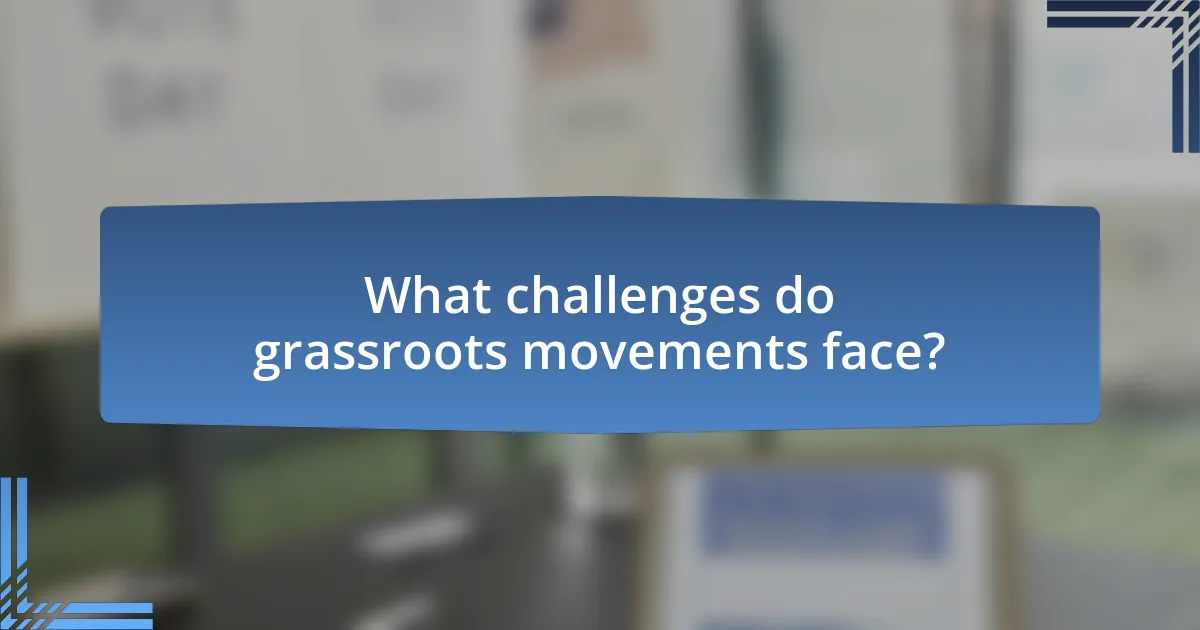
What challenges do grassroots movements face?
Grassroots movements face significant challenges, including limited funding, organizational fragmentation, and resistance from established political entities. Limited funding restricts their ability to mobilize resources effectively, as many grassroots initiatives rely on small donations and volunteer efforts. Organizational fragmentation occurs when diverse groups with overlapping goals fail to coordinate, leading to inefficiencies and diluted impact. Additionally, established political entities often resist grassroots movements, employing tactics such as lobbying, misinformation, or legal challenges to undermine their efforts. These challenges hinder the effectiveness and sustainability of grassroots movements in achieving their objectives.
How do funding and resource limitations impact grassroots mobilization?
Funding and resource limitations significantly hinder grassroots mobilization by restricting the ability to organize, communicate, and sustain efforts. When financial resources are scarce, grassroots organizations struggle to cover essential costs such as outreach materials, event logistics, and staff compensation, which are crucial for effective mobilization. For instance, a study by the National Democratic Institute found that organizations with limited funding often fail to reach broader audiences, resulting in decreased participation and engagement in political movements. Additionally, resource constraints can lead to reliance on fewer volunteers, which may diminish the diversity and effectiveness of grassroots campaigns.
What strategies can grassroots movements employ to overcome financial barriers?
Grassroots movements can employ crowdfunding, community fundraising events, and strategic partnerships to overcome financial barriers. Crowdfunding platforms like GoFundMe and Kickstarter enable grassroots organizations to raise small amounts of money from a large number of people, effectively democratizing funding. Community fundraising events, such as bake sales or local concerts, not only generate funds but also foster community engagement and support. Additionally, forming strategic partnerships with local businesses or nonprofits can provide access to resources and financial support, as seen in successful campaigns like the Women’s March, which utilized partnerships to amplify their reach and funding. These strategies collectively enhance financial sustainability and empower grassroots movements to achieve their goals.
How can grassroots movements effectively utilize volunteer support?
Grassroots movements can effectively utilize volunteer support by implementing structured recruitment, training, and engagement strategies. Structured recruitment ensures that volunteers are aligned with the movement’s goals, while training equips them with necessary skills, enhancing their effectiveness. Engaging volunteers through regular communication and recognition fosters a sense of community and commitment. Research indicates that organizations with strong volunteer management practices see a 50% increase in volunteer retention rates, demonstrating the importance of these strategies in maximizing volunteer contributions.
What external factors influence the success of grassroots mobilization?
External factors that influence the success of grassroots mobilization include political climate, media coverage, community demographics, and funding availability. The political climate can either facilitate or hinder mobilization efforts; for instance, supportive legislation can empower grassroots movements, while repressive policies can stifle them. Media coverage plays a crucial role in shaping public perception and awareness, as seen in movements like the Arab Spring, where social media amplified grassroots messages. Community demographics, such as socioeconomic status and cultural background, affect participation levels and the types of issues prioritized. Lastly, funding availability can determine the resources for outreach and organization, with studies indicating that well-funded movements tend to have higher visibility and impact.
How do political climates affect grassroots movements?
Political climates significantly influence grassroots movements by shaping the environment in which these movements operate. A supportive political climate can enhance mobilization efforts, as seen in the Arab Spring, where widespread discontent with authoritarian regimes led to mass protests and grassroots organizing. Conversely, a repressive political climate can stifle grassroots initiatives, as evidenced by the crackdown on protests in countries like Belarus, where government repression has hindered the ability of grassroots movements to gain traction. The effectiveness of grassroots movements often correlates with the level of political freedom, public sentiment, and the responsiveness of institutions, highlighting the critical role that political contexts play in determining the success or failure of these movements.
What role does media coverage play in shaping public perception of grassroots efforts?
Media coverage significantly influences public perception of grassroots efforts by amplifying their visibility and framing the narrative surrounding them. When media outlets report on grassroots movements, they can highlight key issues, mobilize support, and shape public discourse, which can lead to increased awareness and engagement. For instance, the coverage of the Black Lives Matter movement in major news outlets has played a crucial role in bringing attention to systemic racism and police brutality, resulting in widespread public support and policy discussions. Studies have shown that media framing can affect how audiences interpret the legitimacy and urgency of grassroots initiatives, ultimately impacting their success and sustainability.
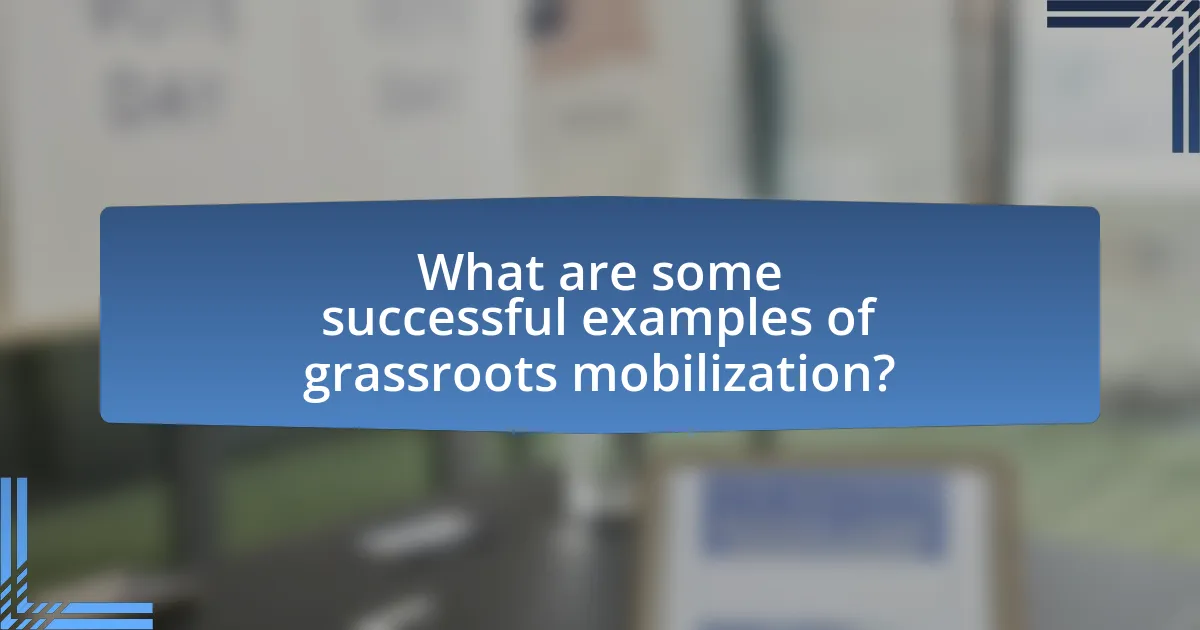
What are some successful examples of grassroots mobilization?
Successful examples of grassroots mobilization include the Civil Rights Movement in the United States, which effectively organized local communities to challenge racial segregation and discrimination through protests, sit-ins, and voter registration drives. Another notable example is the Women’s March on Washington in 2017, where millions mobilized globally to advocate for women’s rights and social justice, demonstrating the power of collective action. Additionally, the Fight for $15 campaign successfully mobilized fast-food workers to demand a $15 minimum wage, leading to significant policy changes in various cities and states. These instances illustrate how grassroots efforts can lead to substantial social and political change.
How have historical movements utilized grassroots strategies effectively?
Historical movements have effectively utilized grassroots strategies by mobilizing local communities to drive social and political change. For instance, the Civil Rights Movement in the United States employed grassroots organizing to engage individuals at the community level, leading to significant events like the Montgomery Bus Boycott in 1955, which was initiated by local activists such as Rosa Parks and supported by organizations like the Montgomery Improvement Association. This grassroots approach not only raised awareness but also built a strong network of support that amplified their message and demands for equality. Additionally, the anti-apartheid movement in South Africa effectively used grassroots strategies by organizing local protests and community meetings, which helped to unify diverse groups against the oppressive regime, ultimately contributing to the dismantling of apartheid in the early 1990s. These examples demonstrate that grassroots strategies can mobilize collective action, foster community engagement, and create a powerful platform for change.
What lessons can be learned from successful grassroots campaigns?
Successful grassroots campaigns demonstrate the importance of community engagement and mobilization. These campaigns often succeed by building strong local networks that foster trust and collaboration among participants. For instance, the 2008 Obama campaign effectively utilized grassroots organizing by leveraging social media to connect with voters, resulting in over 1.5 million volunteers and significant voter turnout. Additionally, successful campaigns emphasize clear messaging that resonates with the target audience, as seen in the Fight for $15 movement, which effectively communicated the need for a living wage. Furthermore, adaptability is crucial; campaigns that respond to changing circumstances and feedback from constituents tend to perform better, as evidenced by the rapid adjustments made during the Black Lives Matter protests in response to public sentiment. These lessons highlight the significance of community, messaging, and adaptability in grassroots mobilization strategies.
How did grassroots mobilization contribute to significant political changes?
Grassroots mobilization significantly contributed to political changes by empowering ordinary citizens to organize, advocate, and influence decision-making processes. This form of mobilization often leads to increased voter turnout, as seen in the 2008 U.S. presidential election, where grassroots efforts helped Barack Obama secure a historic victory by engaging diverse communities and utilizing social media for outreach. Additionally, grassroots movements have successfully challenged established political norms, exemplified by the Civil Rights Movement, which utilized local organizing to dismantle segregation laws and promote voting rights, resulting in the passage of the Voting Rights Act of 1965. These examples illustrate how grassroots mobilization can effectively reshape political landscapes by fostering civic engagement and driving legislative change.
What contemporary examples illustrate effective grassroots mobilization?
Contemporary examples illustrating effective grassroots mobilization include the Black Lives Matter movement and the climate activism led by Greta Thunberg and the Fridays for Future initiative. The Black Lives Matter movement gained significant traction through social media campaigns, local protests, and community organizing, resulting in widespread awareness and policy discussions around racial injustice and police reform. In 2020, protests across the United States and globally mobilized millions, demonstrating the power of grassroots efforts to influence public discourse and legislative action. Similarly, Greta Thunberg’s Fridays for Future movement mobilized students worldwide to strike for climate action, leading to global climate strikes that attracted millions of participants and heightened awareness of climate issues. These movements exemplify how grassroots mobilization can effectively engage communities, influence policy, and drive social change.
How did social media play a role in recent grassroots movements?
Social media significantly facilitated recent grassroots movements by enabling rapid communication and mobilization among supporters. Platforms like Twitter and Facebook allowed activists to share information, organize events, and amplify their messages to a broader audience, often leading to viral campaigns. For instance, the Black Lives Matter movement gained momentum through social media, with hashtags like #BlackLivesMatter trending globally, which helped raise awareness and mobilize protests in response to police violence. Additionally, studies have shown that social media can increase participation rates in protests, as evidenced by the Arab Spring, where social media was crucial in coordinating demonstrations across multiple countries.
What innovative strategies were employed in these movements?
Innovative strategies employed in grassroots mobilization for political movements include the use of social media platforms for rapid information dissemination and community engagement. For instance, movements like the Arab Spring utilized Twitter and Facebook to organize protests and share real-time updates, which significantly increased participation and visibility. Additionally, decentralized leadership structures allowed for more inclusive participation, empowering local leaders to adapt strategies to their specific contexts. Research indicates that these approaches not only enhanced mobilization efforts but also fostered a sense of community and collective identity among participants, as evidenced by the widespread solidarity seen during events like the Women’s March in 2017.
What best practices can enhance grassroots mobilization efforts?
Effective grassroots mobilization efforts can be enhanced by building strong community relationships, utilizing social media strategically, and providing clear messaging. Strong community relationships foster trust and engagement, which are essential for mobilization; for instance, organizations that actively involve local leaders often see increased participation rates. Strategic use of social media allows for rapid dissemination of information and mobilization of supporters, as evidenced by the success of movements like Black Lives Matter, which effectively utilized platforms to organize protests and share resources. Clear messaging ensures that the goals and actions of the movement are easily understood, which has been shown to increase volunteer recruitment and retention, as seen in the campaigns of successful political movements.
How can grassroots movements effectively engage and retain volunteers?
Grassroots movements can effectively engage and retain volunteers by fostering a strong sense of community and purpose. Creating an inclusive environment where volunteers feel valued and connected to the mission enhances their commitment. Research indicates that organizations with high volunteer retention rates often implement regular training sessions and provide clear communication about roles and expectations, which helps volunteers feel competent and informed. Additionally, recognizing and celebrating volunteer contributions through events or public acknowledgment can significantly boost morale and encourage ongoing participation. For instance, a study by the Corporation for National and Community Service found that volunteers who receive recognition are more likely to continue their involvement, demonstrating the importance of appreciation in volunteer retention strategies.
What are the key elements of a successful grassroots campaign plan?
A successful grassroots campaign plan includes clear objectives, a targeted audience, effective messaging, mobilization strategies, and a robust evaluation process. Clear objectives define the campaign’s goals, such as increasing voter turnout or raising awareness on specific issues. Identifying a targeted audience ensures that the campaign reaches individuals who are most likely to support the cause, enhancing engagement. Effective messaging communicates the campaign’s purpose and resonates with the audience, often utilizing emotional appeals or relatable narratives. Mobilization strategies involve organizing volunteers, leveraging social media, and conducting outreach efforts to encourage participation. Finally, a robust evaluation process assesses the campaign’s effectiveness through metrics such as engagement rates and feedback, allowing for adjustments and improvements. These elements are supported by successful case studies, such as the 2008 Obama campaign, which effectively utilized grassroots strategies to mobilize millions of voters.
